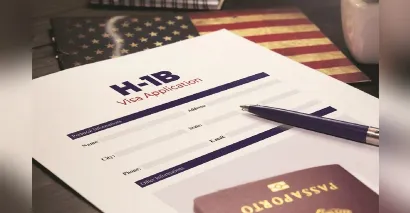Key Highlights
- The New Fee and Its Significance
- Universities in the Crosshairs: The 25 Most Affected
- Ripple Effects Across Research, Enrollment, and Education
- Legal Pushback and Institutional Resistance
- What Students, Scholars & Universities Should Watch For?
- Broader Implications & Risks
- Case In Point: Stanford, Columbia, Michigan & More
- Possible Policy Paths & Mitigations
- Conclusion
As a sudden departure from the established visa policy, the Trump administration has proposed a new H-1B application fee of $100,000, which is likely to dismantle the historic academic pipeline of international scholars and student. Traditionally, some exemptions or lower costs of H-1B regulations were enjoyed by universities and research institutions; at this point, even these institutions are firmly in the target. This increase, in combination with a shift in the rules of the lottery and the selection of a visa, is likely to destabilize enrollment, research, and international flows of talent, especially at the 25 U.S. universities that rely most on H-1B hires.
We discuss the implications, the most vulnerable institutions, the brewing legal friction, and the possible reaction of the students, faculty, and colleges in this changing environment below.
The New Fee and Its Significance
Tsignificance of the new fee is:
From Thousands to Six Figures
Hitherto, universities, non-profits, and some research institutions paid relatively small filing fees (generally, 2-5000 in accordance with the size) to sponsor H-1B applicants. The same institutions are now required to contribute $100,000 per H-1B application in the new regime. This melodramatic turn of events makes the administrative cost that was initially manageable a huge financial liability.
Why Universities Are Suddenly Vulnerable
In the H-1B visa program, universities were also given preference in the past by being placed under a special non-profit or cap-exempt category to enable them to bring foreign workers on board throughout the year without being bound by the lottery restrictions every year. That cushion, however, with the new rules, is weakened. However, immigration experts are of the view that these institutions, officially exempt, are technically on the frontlines of the policy change as their waiver protections are evaporating.
Besides, the new lottery regulations favor the older and better-compensated applicants, which leaves the early-career researchers and recent graduates, the mainstay of academic recruitment, squarely in a disadvantaged position.
Also Read: Intracompany Transfer Visa USA
Universities in the Crosshairs: The 25 Most Affected
The universities most susceptible to the new H-1B fee of 100,000 dollars are the ones that have had the highest number of visa renewals and the highest percentages of international student population. Stanford University is expected to take the first place among the leading universities with approximately 500 H-1B approvals from October 2024 to June 2025. The graduate students at Stanford are approximately 36 percent of foreign nationals, and therefore, the increment fee might have severe implications on its research hiring and postdoctoral programmes.
Columbia University comes in second with a little over 204 H-1B approvals and a population of international graduate students numbering nearly 46%. The drastic upward cost can compel Columbia to use greater resources in visa processing, which will influence student and staff recruitment.
At the University of Michigan, where there were approximately 359 approvals, and a third of the total graduate students are foreign, the effect is set to trickle down to the engineering, computer science, and medical divisions that are highly dependent on international knowledge and skills. Likewise, Washington University in St. Louis, which has approximately 285 approvals and a presumed 46 percent of international graduate students, might face significant difficulties in maintaining its medical research and academic diversity.
Finally, the University of Pennsylvania, having approximately 225 H-1B petitions and 31 percent of foreign graduates, will also lose much in terms of being a competitive global researcher. In the case of these institutions, this new visa fee is not just a financial barrier, but even the end of the international collaboration and innovation ecosystems of these institutions.
Ripple Effects Across Research, Enrollment, and Education
The ripple effect across research, enrollment, and education:
A Squeeze on Research & Innovation
Terminating or halting foreign researchers might pose a serious impediment to the output, particularly at institutions that depend on postdoctoral, PhD, and foreign faculty recruitment. Things like laboratories, technological transfer, grants, and institutional prestige may not fare well.
Enrollment Declines & Financial Stress
The enrollment of international students is already beginning to show stress: the U.S. had been recording a 19 percent decline in international student arrival in August year to year, with a further 28 percent drop in July. Acute losses may be experienced in graduate programs, particularly in STEM, which would impact cash flows, scholarship funding, and diversity on campuses.
Competitive Disadvantage vs. Other Countries
International talent is being actively recruited in countries such as Canada, Australia, and some parts of Europe. With an increase in U.S. visa barriers, foreign institutions can have a competitive advantage in attracting the best scholars and students.
Internal Institutional Response & Reorganization
Universities might have to re-examine their recruitment process, allocate more resources to domestic talent, or eliminate jobs. The departments that are highly dependent on international employees (e.g., AI, life sciences) can be markedly reduced and transform academic landscapes over time.
Also Read: US Visitor Visa B1/B2
Legal Pushback and Institutional Resistance
The legal pushback and institutional resistance are:
Lawsuit Challenging the Fee
A group of unions, educators, healthcare providers, and religious institutions has also brought a lawsuit in the Northern District of California claiming that the president exceeded powers through enforcing a revenue-raising measure without Congress and going around the necessary regulatory notice.
The plaintiffs caution that the fee will cut vital services in education, health, and nonprofit areas - where foreign professionals work in large numbers.
Constitutional & Regulatory Arguments
-
Separation of Powers: By imposing such a significant change in revenue through executive order, Congress has been avoided.
-
Arbitrary Rulemaking: The change in fees can not be procedurally publicly announced, or commented on, or even based.
-
Damage to Nonprofits: The plaintiffs argue that most institutions just can not afford a six-figure per-hire price.
Uncertain Outcomes, High Stakes
Judges can issue injunctions or pause sections of the rule, but in any case, the court procedure can be months or years long. In the meantime, universities are already forced to operate and make decisions in uncertainty.
What Students, Scholars & Universities Should Watch For?
The students, scholars and universities should watch for:
Students & Prospective Scholars
-
Research visa support for review of graduate programs.
-
Add uncertainty in work post-study.
-
Give priority to the programs or institutions in the supportive states or systems that are going through the H-1B with more strength.
Faculty & Researchers
-
Discuss the terms of the contract in order to mitigate visa risk.
-
Familiarize oneself with other visa options (e.g., O-1, J-1, other options) when possible.
-
Keep research partnerships and cross-border mobility fluid.
University Administrators
-
Evaluate internal cost models and modify budgets to accept new visa overheads.
-
Lobby together through the higher education associations (e.g., AAU, APLU) to have relief or rollback in the legislature or regulations.
-
Rediscover recruiting pipelines and approaches sensitive to visa expenses.
Broader Implications & Risks
The broader implications and risks are:
Brain Drain from the U.S. to Other Destinations
The best foreign talent may start to avoid the U.S. and choose other immigration policies that are more welcoming, causing a permanent loss of American research hegemony.
Domestic Workforce Challenges
There are areas that do not have the domestic talent at the required magnitude. Cessation of access to international expertise might slow innovation, biotechnology, AIs, and high-tech engineering, and trickle down on its competitive edge.
Equity & Diversity Ramifications
Global perspectives and demographic diversity are usually brought by international students and faculty. Their shrinkage could unite academic communities and decrease intercultural exchange.
Institutional Reputation & Collaboration
In case of research output, publication, cross-institutional projects loss, reputational and ranking effects may occur, which is reflected in enrollment and funding cycles.
Case In Point: Stanford, Columbia, Michigan & More
We can have a closer look at some of the infected institutions:
-
Stanford University (~500 new/renewal H-1Bs): Stanford University, being an innovation center and a technological giant, is in dire need of foreign researchers. The cost of hiring a single professional (researcher) based on $100K can deter labs in terms of downsizing or hiring.
-
Columbia University (~204 approvals): The number of its graduate cohort that is international is almost half. The charge may have an enormous impact on the budget or scholarship distribution.
-
Washington University (285 approvals): In such disciplines as medicine and life sciences, visa-based hiring is essential (Washington University in St. Louis, approximately 285 approvals, approximately 46 percent foreign). The issues of staffing may spread from department to department.
-
University of Michigan (~359 approvals): Michigan has good engineering, AI, and data science programs, and this can lead to the scaling back of more ambitious research projects.
-
It is up to them to Make Tough Decisions: Either absorb the expenses, hire less, or switch to other models, just to preserve their academic and research competitive advantage.
Also Read: Difference Between B1 and B2 Visa USA: Experts' New Guide
Possible Policy Paths & Mitigations
The possible policy paths and mitigations are:
Congressional Action
The first path is legislative backlash, namely, Congress might enact laws to restrict or reverse the charge, revive exemptions, or take charge of visa fee arrangements. There is a high possibility that higher education lobbying groups are already mobilizing.
Regulatory Delay or Reversal
Agencies are allowed to seek injunctions, stall action, or even reconsider rules under duress. Law issues will cause some reversal or cut off areas of learning institutions.
Institutional Cost-Sharing or Endowments
Other leading universities may resort to endowment funds or establish a system of cost-sharing between departments to deal with the new load, but this is not sustainable with many.
Alternative Visas or Hybrid Models
Institutions can as much as possible rely more on J-1, O-1, or other types of visas, or international collaborative models that locate researchers abroad with remote contribution.
Proactive Recruitment Strategy Diversification
Institutions could increase the diversity of their hiring workforce by hiring more domestic scholars or simply changing the focus to less-reliant student groupings.
Conclusion
A requirement of a highly inflationary fee of H-1B of 1,00,000 for universities is a radical shift in the attitude of America to international academic talent. Those institutions that previously depended on foreseeable visa pipelines are today confronting astronomical expenditures, legal insecurity, and strategic disorientation. The most vulnerable 25 universities (including Stanford, Columbia, Michigan, and Washington University) may experience an immediate effect on research staffing, student enrollment, and institutional reputation.
However, the consequences of the action are felt much further afield: they are now affecting students, faculty, and institutions nationally to have to adjust themselves to a new immigration regime that is seen as turning universities into for-profit enterprises and not educational locations. The next months will be crucial, whether it will be with litigation, legislative relief, or creative institutional manoeuvre. The issue is whether the United States can continue to be a beacon of academic excellence to scholars of the world or give way to more accommodating countries.
Contact TerraTern for more information.








